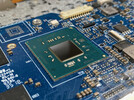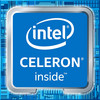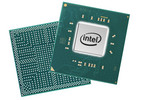Intel Pentium Silver N5000 vs Intel Celeron J4105 vs Intel Celeron J4115
Intel Pentium Silver N5000
► remove from comparison
The Intel Pentium Silver N5000 is a quad-core SoC primarily for inexpensive notebooks and was announced late 2017. It runs at 1.1-2.7 GHz (Single Core Burst, Multi Core Burst max. 2.6 GHz) and is based on the Gemini Lake platform. Similar to the Apollo Lake predecessor, the chip is manufactured in a 14 nm process with FinFETs but offers slightly improved processor cores, double the amount of L2 cache, a smaller package, a new generation of monitor outputs (Gen 10) and a partly integrated WiFi chip. Besides four CPU cores, the chip also includes a DirectX 12 capable GPU as well as a DDR4/LPDDR4 memory controller (dual-channel, up to 2400 MHz). The SoC is not replaceable as it is directly soldered to the mainboard.
Architecture
The processor architecture was slightly reworked and is now called Goldmont Plus. It features an increased level 2 cache (to 4 MB). That means the per-clock-performance should be a bit better, but not near the Core CPUs like Kaby Lake Y.
Performance
The average N5000 in our database is in the same league as the AMD 3050e and the Pentium 4415U, as far as multi-thread benchmark scores are concerned. This is a really poor result, as of Q3 2023.
The Yoga 330-11IGM is among the fastest laptops featuring the N5000 that we know of. It can be more than 30% faster in CPU-bound workloads than the slowest system built around the same chip in our database, as of August 2023.
GPU Performance
The UHD Graphics 605 (Gemini Lake) is based on Intel's Gen9 architecture, which supports DirectX 12 and is also used for the Kaby Lake / Skylake / Apollo Lake graphics adapters (like HD Graphics 520). Equipped with 18 EUs and a clock of up to 750 MHz, the performance should be roughly on par with the older HD Graphics 5300 and HD Graphics 505 (Apollo Lake).
The chip also includes an advanced video engine with hardware support for the playback of VP9 and H.265 material (8-bit color-depth).
Power Consumption
Similar to the predecessor, Intel specifies the TDP with 6 Watts (SDP 4.8 Watts – Scenario Design Power). The chip can therefore be cooled passively in theory, but SKUs with fans are possible as well.
Intel Celeron J4105
► remove from comparison
The Intel Celeron J4105 is a quad-core desktop SoC primarily for mini PCs and mini ITX mainboards. It runs at 1.5 - 2.5 GHz (Single Core Burst) and is based on the Gemini Lake platform. Similar to the Apollo Lake predecessor, the chip is manufactured in a 14 nm process with FinFETs but offers slightly improved processor cores, double the amount of L2 cache, a smaller package, a new generation of monitor outputs (Gen 10) and a partly integrated WiFi chip. Besides four CPU cores, the chip also includes a DirectX 12 capable GPU as well as a DDR4/LPDDR4 memory controller (dual-channel, up to 2400 MHz). The SoC is not replaceable as it is directly soldered to the mainboard.
Architecture
The processor architecture was slightly reworked and is now called Goldmont Plus. It features an increased level 2 cache (to 4 MB). That means the per-clock-performance should be a bit better, but not near the Core CPUs like Kaby Lake Y.
Performance
While we have not tested a single system built around the J4105 as of August 2023, we have tested a certain number of laptops featuring the Celeron N4120, a chip with very similar specs (4 cores, 4 threads, up to 2.6 GHz). Based on that, expect the J4105 to be very slow in all but the most basic activities.
Intel Celeron J4115
► remove from comparison
The Intel Celeron J4115 is a quad-core SoC primarily for inexpensive mini PCs and was announced late 2017. It runs at 1.8 GHz to 2.5 GHz (Single Core Burst) and is based on the Gemini Lake platform. Similar to the Apollo Lake predecessors, the chip is manufactured on a 14 nm process with FinFETs but offers slightly improved processor cores, double the amount of L2 cache, all in a smaller package. Partial Wi-Fi 5 support is baked into the chip. Besides four CPU cores, the chip also includes a DirectX 12 capable GPU as well as a DDR4/LPDDR4 memory controller (dual-channel, up to 2400 MHz). The processor is not replaceable as it is directly soldered to the mainboard.
Architecture
The processor architecture ist still called Goldmont Plus. Compared to the older Goldmont cores in Apollo Lake, they feature a larger L2 cache (now 4 MB). That means the per-clock-performance should be a bit better, but not anywhere near the Core CPUs like Kaby Lake Y.
Performance
The average J4115 in our database only just matches the Core i5-4260U, a somewhat more power-hungry SoC that saw the light of day in 2014, in multi-thread performance. This means the Celeron is a very basic CPU that isn't really ready to handle anything beyond the most basic tasks such as writing e-mails and listening to Spotify.
Graphics
The UHD Graphics 600 (Gemini Lake) is based on Intel's Generation 9 architecture, which supports DirectX 12 and is also used for the Kaby Lake / Skylake / Apollo Lake graphics adapters (like HD Graphics 520). Equipped with 12 EUs and a clock of up to 750 MHz, the performance should be roughly on par with the older HD Graphics 500 (Apollo Lake).
The chip also includes an advanced video engine with hardware support for the playback of VP9 and H.265 (8-bit color-depth).
Power consumption
Like most other J-class Intel processors, the Celeron has a default TDP (also known as the long-term power limit) of 10 W. This is low enough to allow laptop makers to build passively cooled laptops, mini-PCs, tablets and other gadgetry around the chip.
The Intel Celeron J4115 is built with one of the old 14 nm Intel processes for poor, as of early 2023, energy efficiency.
| Model | Intel Pentium Silver N5000 | Intel Celeron J4105 | Intel Celeron J4115 | ||||||||||||||||||||||||||||||||||||||||||||||||||||||||||||||||||||||||
| Codename | Gemini Lake | Gemini Lake | Gemini Lake | ||||||||||||||||||||||||||||||||||||||||||||||||||||||||||||||||||||||||
| Series | Intel Gemini Lake | Intel Gemini Lake | Intel Gemini Lake | ||||||||||||||||||||||||||||||||||||||||||||||||||||||||||||||||||||||||
| Series: Gemini Lake Gemini Lake |
|
|
| ||||||||||||||||||||||||||||||||||||||||||||||||||||||||||||||||||||||||
| Clock | 1100 - 2700 MHz | 1500 - 2500 MHz | 1800 - 2500 MHz | ||||||||||||||||||||||||||||||||||||||||||||||||||||||||||||||||||||||||
| L1 Cache | 224 KB | ||||||||||||||||||||||||||||||||||||||||||||||||||||||||||||||||||||||||||
| L2 Cache | 4 MB | 4 MB | 4 MB | ||||||||||||||||||||||||||||||||||||||||||||||||||||||||||||||||||||||||
| Cores / Threads | 4 / 4 | 4 / 4 | 4 / 4 | ||||||||||||||||||||||||||||||||||||||||||||||||||||||||||||||||||||||||
| TDP | 6 Watt | 10 Watt | 10 Watt | ||||||||||||||||||||||||||||||||||||||||||||||||||||||||||||||||||||||||
| Technology | 14 nm | 14 nm | 14 nm | ||||||||||||||||||||||||||||||||||||||||||||||||||||||||||||||||||||||||
| max. Temp. | 105 °C | 105 °C | 105 °C | ||||||||||||||||||||||||||||||||||||||||||||||||||||||||||||||||||||||||
| Socket | BGA1090 | BGA1090 | BGA1090 | ||||||||||||||||||||||||||||||||||||||||||||||||||||||||||||||||||||||||
| Features | DDR4-2400/LPDDR4-2400 RAM, PCIe 2, MMX, SSE, SSE2, SSE3, SSSE3, SSE4.1, SSE4.2, SMEP, SMAP, MPX, EIST, TM1, TM2, Turbo, AES-NI, RDRAND, RDSEED, SHA, SGX | DDR4-2400/LPDDR4-2400 RAM, PCIe 2, MMX, SSE, SSE2, SSE3, SSSE3, SSE4.1, SSE4.2, VMX, SMEP, SMAP, MPX, EIST, TM1, TM2, Turbo, AES-NI, RDRAND, RDSEED, SHA, SGX | DDR4-2400/LPDDR4-2400 RAM, PCIe 2, MMX, SSE, SSE2, SSE3, SSSE3, SSE4.1, SSE4.2, VMX, SMEP, SMAP, MPX, EIST, TM1, TM2, Turbo, AES-NI, RDRAND, RDSEED, SHA, SGX | ||||||||||||||||||||||||||||||||||||||||||||||||||||||||||||||||||||||||
| iGPU | Intel UHD Graphics 605 (200 - 750 MHz) | Intel UHD Graphics 600 (250 - 750 MHz) | Intel UHD Graphics 600 (250 - 750 MHz) | ||||||||||||||||||||||||||||||||||||||||||||||||||||||||||||||||||||||||
| Architecture | x86 | x86 | x86 | ||||||||||||||||||||||||||||||||||||||||||||||||||||||||||||||||||||||||
| $161 U.S. | $107 U.S. | ||||||||||||||||||||||||||||||||||||||||||||||||||||||||||||||||||||||||||
| Announced | |||||||||||||||||||||||||||||||||||||||||||||||||||||||||||||||||||||||||||
| Manufacturer | ark.intel.com | ark.intel.com | ark.intel.com |
Benchmarks
Average Benchmarks Intel Pentium Silver N5000 → 100% n=2
Average Benchmarks Intel Celeron J4105 → 104% n=2
Average Benchmarks Intel Celeron J4115 → 97% n=2
* Smaller numbers mean a higher performance
1 This benchmark is not used for the average calculation













